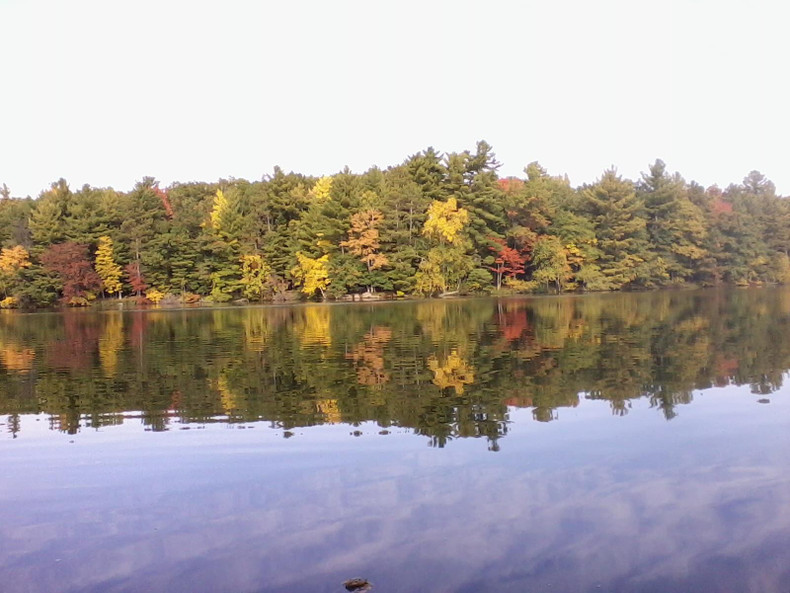Fall is quickly approaching and with the cooler temperatures and shorter days comes the time to think about preparing your pond for winter and the coming season. It’s never too early to plan for next year and we at ABI have a few suggestions to get you thinking about preventative pond maintenance.
The cooler water temperatures in fall is the ideal time to stock fathead minnows and other gamefish. Minnows are not only a food source for predatory fish, 8 pounds of fathead minnows grow 1 pound of largemouth bass, but they also act like vacuum cleaners as a preventative maintenance tool. Minnows are active 24/7 eating organics, algae, goose waste, leaf litter, mosquito larvae, the list goes on and on. Fathead minnows are an excellent way to tie up nutrients that might have otherwise been used to fuel aquatic plant and algae growth. Depending on the literature sited, 1 pound of fathead minnows equals the amount of nutrients found in 350-500 pounds of dry algae! At a stocking rate of 150 pounds per acre, you could be tying up 75,000 pounds of algae per acre!
Whether it be spawning areas or hiding places, ensuring your pond has adequate habitat to support fish is an important consideration. Fathead minnows reproduce 3-4 times per season and need their own little space to guard the fry and protect themselves from predators. It could be as simple as hardwood trees anchored to the bottom, hardwood pallets or a number of commercially available structures. Our Fathead Minnow Fortresses are specifically designed as a fathead minnow spawning structure, allowing a single male to claim a tube as “his area” for the season. Male fathead minnows are very territorial, and the design of the ABI Fathead Minnow Fortress maximizes nesting sites by limiting visual contact between neighboring males – meaning they will spend less energy fighting and more energy on attracting females and caring for the eggs. They also offer a protection area for the minnows to escape predators. Does your pond have adequate habitat to support fish?
Dissolved oxygen is the single most important water quality parameter. DO creates a favorable environment for aquatic life; especially the natural bacteria and microbes that help maintain clean healthy water. Adequate aeration helps lessen algae’s preferred growing environment, provides the friendly environment for beneficial bacteria which in turn feeds on, reduces accumulation of bottom organic sediment, increases the fish carrying capacity, and keeps fish healthy throughout the winter and summer. Aeration also allows you and us to use many other effective tools to help improve water clarity and water quality. Is your pond a stress free environment for the fish?
Aeration systems require routine maintenance to operate efficiently. Filters should be changed and diffusers acid washed on a seasonal basis. If your diffusers weren’t cleaned in the spring consider cleaning them this fall. Are you maintaining your aeration system annually?
When air temperatures drop in fall, waterbodies turn over or mix which creates dissolved oxygen from the top to the bottom. To save money on operating costs, you could shut off your compressor when water temperatures reach 60°F and leave them off until the ice forms, then turn it on and adjust the valves to run less diffusers. Cold water holds more oxygen so less aeration is needed in winter.
The running diffuser(s) should be moved to shallow water closer to shore so they create a smaller open area. Diffusers in deeper water can super cool the water in winter and stress fish. If a dog or animal falls in the water, they can usually get out when the opening is close to shore. In spring, when the ice is melted, the compressor can be turned off, usually around March 15 as the ice breaks. Move the shallow diffuser back to the summer location and turn your compressor and all diffusers on for summer operation around April/May, when water temperatures reach 50°F, or before algae becomes an issue. What are your ice covered DO levels? Do you need to aerate in winter?
Aerating water is our major business. There are many other less expensive and less efficient systems on the market today, but our Aqua Bio systems are state of the art, extremely efficient, low maintenance, and long lasting. If you are considering any other system or if your system is under/oversized for your waterbody we can advise you on how to improve your current system. Consider this alone: our stainless steel diffusers come with a 20 year warranty. Our diffuser flow through design is, at a minimum, 38% MORE efficient than rubber bladder or ceramic stone diffuser and require less horsepower to operate. If you are aerating with more than a ¼ hp of compressor per acre in winter you should call us for cost saving advantages.
Fall also means migrating geese might want to pay a visit to your pond. Every goose produces 3.4 pounds of waste per day. This equates to a lot of extra added nutrients when a flock comes through to spend the night. Geese like open, easy access areas so they can watch out for predators. Do you have a 3-4 feet tall buffer zone around your pond to discourage geese? Not only does this buffer zone limit goose activity, it also acts as a filter to absorb nutrients in runoff and sediment as water flows into your pond as well as stop leaf litter and grass clippings from being blown into the pond. These buffer zones can look very attractive when planted with a mix of wildflowers or native.
Now is the time to plan ahead for next spring and summer’s growing season. The quality of your water reflects the quality of the management.

